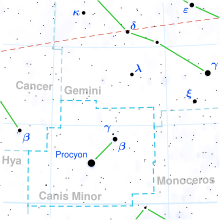| Observation data Epoch J2000.0 Equinox J2000.0 (ICRS) | |
|---|---|
| Constellation | Canis Minor |
| Right ascension | 07h 25m 38.89613s[1] |
| Declination | +09° 16′ 33.9541″[1] |
| Apparent magnitude (V) | +5.002[2] |
| Characteristics | |
| Spectral type | G6.5 IIb[3] |
| U−B color index | +0.774[2] |
| B−V color index | +1.004[2] |
| Astrometry | |
| Radial velocity (Rv) | −7.8±1.3[4] km/s |
| Proper motion (μ) | RA: −3.338 ± 0.385[5] mas/yr Dec.: −8.497 ± 0.310[5] mas/yr |
| Parallax (π) | 4.2624 ± 0.2288 mas[5] |
| Distance | 770 ± 40 ly (230 ± 10 pc) |
| Absolute magnitude (MV) | −2.62[6] |
| Details[7] | |
| Mass | 4.63±0.17 M☉ |
| Radius | 45.51±4.34 R☉ |
| Luminosity | 1,086.5±197.8 L☉ |
| Surface gravity (log g) | 1.81±0.06 cgs |
| Temperature | 4,916±70 K |
| Metallicity [Fe/H] | −0.12±0.10 dex |
| Rotational velocity (v sin i) | 8[8] km/s |
| Age | 140±10 Myr |
| Other designations | |
| Database references | |
| SIMBAD | data |
Epsilon Canis Minoris (ε Canis Minoris) is a suspected binary star[10] system in the equatorial constellation of Canis Minor. It is a fifth magnitude star, which means it is bright enough to be faintly visible to the naked eye.[2] Based upon an annual parallax shift of just 3.13 mas as seen from Earth,[1] this star is located roughly 770 light years from the Sun, give or take a 40 light year margin of error.[5]
This is an evolved G-type bright giant star with a stellar classification of G6.5 IIb.[3] It is most likely (99% chance) on the horizontal branch,[7] and is a barium star that shows an abnormal overabundance of barium in its spectrum.[11] This s-process element may have been accreted from a now white dwarf companion during a previous stage of its evolution.[10] The bright giant component has an estimated 4.63 times the mass of the Sun and has expanded to 45.5 times the Sun's radius. The star is radiating 1,087 times the Sun's luminosity from its enlarged photosphere at an effective temperature of about 4,916 K.[7]
- ^ a b c Cite error: The named reference
vanLeeuwen2007was invoked but never defined (see the help page). - ^ a b c d Cite error: The named reference
Jennens1975was invoked but never defined (see the help page). - ^ a b Cite error: The named reference
perkins1989was invoked but never defined (see the help page). - ^ Cite error: The named reference
deBruijne2012was invoked but never defined (see the help page). - ^ a b c d Brown, A. G. A.; et al. (Gaia collaboration) (August 2018). "Gaia Data Release 2: Summary of the contents and survey properties". Astronomy & Astrophysics. 616. A1. arXiv:1804.09365. Bibcode:2018A&A...616A...1G. doi:10.1051/0004-6361/201833051. Gaia DR2 record for this source at VizieR.
- ^ Cite error: The named reference
Takeda2008was invoked but never defined (see the help page). - ^ a b c Cite error: The named reference
Reffert2015was invoked but never defined (see the help page). - ^ Cite error: The named reference
Bernacca1970was invoked but never defined (see the help page). - ^ Cite error: The named reference
SIMBADwas invoked but never defined (see the help page). - ^ a b Cite error: The named reference
Eggleton2008was invoked but never defined (see the help page). - ^ Cite error: The named reference
Williams1975was invoked but never defined (see the help page).
